Crime Con 2023
Orlando, Florida
Please Note this about a True Crime Convention; therefore it comes with every Trigger Warning.
- Matt Murphy and The Psycho Hunt: Inside the Manhunt for California’s Most Wanted
- Candice DeLong and Killer Psyche: How Today’s Killers Reflect the Past
- Drs. Brucato and Ramsland on Violent Minds: What Drives the Most Heinous Serial Killers?
- K9 Demo by the Orlando PD starring Fletcher and Jackson
- Friday Night with Nancy Grace
- Othram – Roads to Justice: the Future of DNA Analysis
- Ann Wolbert Burgess – A Killer by Designer: Murderers, Manhunters, and My Quest to Decipher the Criminal Mind
- Adam W. Stern, DVM—Dogfighting: The Yard, The Keep, and The Pit
- Missing White Woman Syndrome: Asking the Hard Questions
- Life Imitating Art: How A Hollywood DNA Analyst was Hunted in a Real-World Decade of Terror
- The Murder of Christine Frank: How DNA & Detective Work Led to a Breakthrough After 17 Years
Saturday:
Othram – Roads to Justice: the Future of DNA Analysis
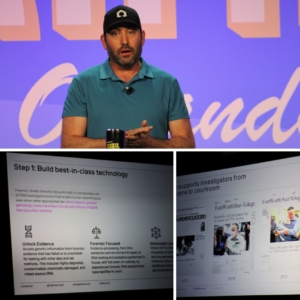
Othram CEO David Mittelman gave an interesting presentation about the company he and his wife co-founded. Mittelman didn’t get into technical details. In a way, that might get too dry for people who aren’t involved in that type of information technology. Plus, I doubt a new CEO would want to give away too much technical information that could be copied by competitors.
Othram fills in a tremendous amount of DNA data that current law enforcement and genealogy kits don’t even close to. Mittleman explained that their technology helps solve cold cases. He encouraged everyone to get involved with building DNA databases—that alone is controversial and gives people the Big Brother vibe. However, he replied when answering someone’s question about privacy that it’s currently voluntary. Personally, I think people are extremist in reactions to things like personal data. You’re either, “Hell no! The gov’mint can’t have my fill in the blank.” Or “If you have nothing to hide then why wouldn’t you submit your fill in the blank.” Blood, saliva, fingerprints, medical history, or anything else law enforcement might want to help them on cases. No doubt, there are a lot of shocking DNA results that end with, “my daddy isn’t my daddy.”
“It’s about the overall reduction of uncertainty,” Mittelman stated as Othram’s mantra. This came through in a variety of ways. “The real enemy of justice is uncertainty.”
He’s not wrong in that regard. Biometrics can actually be wrong or faked with the correct knowledge and resources. Before anyone freaks out about Othram, at the moment they only work with law enforcement agencies. They don’t do the things that consumer DNA tests do. They don’t look for genetic illness markers. They focus only on evidence/forensics. Their partners are the National Institute of Justice (NIJ-funds research) and National Missing and Unidentified Persons System (NAMUS).
If you watch any crime dramas, you probably know about CODIS and AFIS. CODIS is the current nationwide DNA database for law enforcement. AFIS is for fingerprints. Usually a person is not in CODIS unless they’ve been convicted of a felony. If you’re a victim, you’re probably not in CODIS. CODIS is currently limited by its technology. It can only help identify direct DNA familial matches: parents, children, and siblings. You won’t get cousins simply by entering data into CODIS. That currently gets done through a more lengthy process of matching maternal bloodlines through mitochondrial DNA which Mittelman didn’t get into.
With Othram’s system, they can do much more than CODIS’s 20 genetic markers. They can identify hundreds of thousands of markers. Another massive hindrance within today’s law enforcement testing is that once a sample is tested, it’s destroyed by the test.
Mittelman passionately spoke of Othram’s successes. The DNA evidence can be older than systems currently used for testing. There was a case in Australia where a man’s remains had been in the water for 95 years. No one was looking for him because some portion of him (a body part) had been identified previously leaving no open case.
Other limitations of current systems:
- Anthropological analysis of ancestry is limited. It usually requires a full skeleton.
- Facial reconstruction can be extremely flawed.
- Racial “traits” are not precise.
- Cremation ashes are burned at too high a heat and what relatives get are not 100% their loved one. It’s mostly the smallest ashes and anything bigger is discarded.
What Othram wants to see:
- More facilities like theirs; they presently have one facility in Texas.
- Training for their law enforcement partners to close cases.
- A set of standards for the entire chain of the process.
- Specified metrics.
- Upgraded infrastructure.
- Then, make all this technology accessible to all agencies.
- Funding—they are not above crowdfunding in order to close cases. They’ve used GoFundMe before. There’s also the DNASolves website.
If you do have a biological relative that is missing or the victim of a crime, you can pay one of the consumer DNA companies to have yours mapped. Then you can download your data and upload it to a company like GEDMatch. GEDMatch is still limited and intended for people to connect to relatives, but at this time, it’s the only thing laymen can do if they can’t get a law enforcement agency involved.
A Word of Warning:
It was reported that genealogy website, 23andMe was hacked. According to ArsTechnica in a post on October 6, 2023:
TopFriday’s confirmation comes five days after an unknown entity took to an online crime forum to advertise the sale of private information for millions of 23andMe users. The forum posts claimed that the stolen data included origin estimation, phenotype, health information, photos, and identification data. The posts claimed that 23andMe’s CEO was aware the company had been “hacked” two months earlier and never revealed the incident. In a statement emailed after this post went live, a 23andMe representative said “nothing they have posted publicly indicates they actually have any ‘health information.’ These are all unsubstantiated claims at this point.”
23andMe officials on Friday confirmed that private data for some of its users is, in fact, up for sale. The cause of the leak, the officials said, is data scraping, a technique that essentially reassembles large amounts of data by systematically extracting smaller amounts of information available to individual users of a service. Attackers gained unauthorized access to the individual 23andMe accounts, all of which had been configured by the user to opt in to a DNA relative feature that allows them to find potential relatives.
Ann Wolbert Burgess – A Killer by Designer: Murderers, Manhunters, and My Quest to Decipher the Criminal Mind

The absolute legend, Ann Wolbert Burgess, D.N.Sc., APRN, FAAN, was at CrimeCon to announce that she finally took her most infamous and cases and created a book. If you’ve watched the show Mindhunter on Netflix, the character of Dr. Wendy Carr is based on her. Burgess was a nurse who found her way into studying and treating traumatized victims of sexual assault. Before her FBI career, Burgess and Boston College sociologist Lynda Lytle Holmstrom founded one of the first hospital-based crisis counseling programs at Boston City Hospital.
In her career, Burgess has studied and helped young victims of violence to see how that trauma effected their development. She also studies and teaches on elder abuse in nursing homes, cyberstalking, and Internet sex crimes. She’s one of the first people to study and teach Victimology (as you can see by the fictional, but honest portrayals in shows like Mindhunter and Criminal Minds). She includes mental health in with forensic evidence when analyzing subjects. The fact that she endorses these shows for doing a good job with how important the BAU/BSU of the FBI speaks volumes about their quality despite the appearance of cases wrapping up in a day or two.
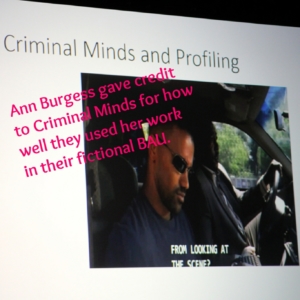
Her presentation was exceptional. She gave briefs on each chapter in her new book with Steven Matthew Constantine, A Killer by Designer: Murderers, Manhunters, and My Quest to Decipher the Criminal Mind. The book is well organized, has a few glossy photo pages, and contains a helpful index.
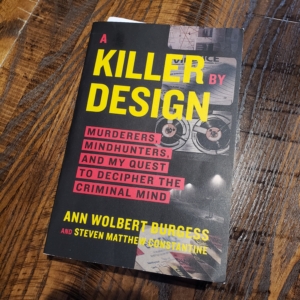
Victim counseling fit in well with her nursing background. It all began to change when the FBI invited her to talk to “The Men” because they didn’t have the same kind of skillset. Up until then, she was used to only speaking with women too. Key figures that moved the FBI into this new thing named the Behavioral Science Unit included Roy Hazelwood, Bob Russell, and William Webster.
Women like Ann Burgess are vital to recognize for their accomplishes and inclusion in history. While many people credit Sherlock Holmes creator, Sir Arthur Conan Doyle with the invention of forensics, one must not leave out the groundbreaking work of Frances Glessner Lee and her Nutshell Studies.
The first case of criminal profiling, Burgess attributes to James Brussel in 1956 with his description of who the New York City Mad Bomber would be. The FBI got fully on board in 1972 as they finished construction of their academy in Quantico, Virginia. Now, in 2023, Burgess finds it important to let people know that the science of criminal profiling is not perfect.
Burgess also included some video clips of the actual interviews the FBI had with serial rapists and murderers. Showing these clips to an attentive audience showed everyone how normal, articulate, and even likable these serial violent offenders can appear. In the interviews, the subjects always made a point of correcting the interviewer when something in the media had been reported incorrectly.
Disappointment in the Scheduling:
The presentation was at 11:40am. Burgess was scheduled for her Meet & Greet (book signing) at 1:40pm. People were already in a long line before she arrived at the designated room. She seemed genuinely pleased that people were interested in her work and with what she had to contribute. However, halfway through the long zig-zag queue of fans, someone came and stopped the book signing. They apologized and said Dr. Burgess needed to leave for an interview. It didn’t look like Burgess knew anything about this. She tried to keep signing while angry and disappointed fans spoke up. Would she be gone for only a short while? Could we stay and wait for her to be done? I mean, by that point, we had been in line for over an hour and most of us seemed okay with sitting on the floor and waiting. I have to say, the loudest of the bunch were, can you guess? Two middle-aged white men. You would’ve thought they were at a ball game.
What made our frustrations even more tense what that this staffer who stopped the signing kept changing their mind. First, they said, “This is the last person,” and pointed to someone in line. Then it changed to, “The next ten people who are in this front row,” so of course people in the line squished tightly together to be in the first row of the zig-zag. Voices grew louder and tension was making the fan experience more like an angry protest. That’s when the staffer gave up and told all of us to forget about what she said. There is no last person in the line anymore. Dr. Burgess had to go and too fucking bad for those of us who had been on our feet the entire time hoping to meet a role model.
TopSunday:
Adam W. Stern, DVM—Dogfighting: The Yard, The Keep, and The Pit

Dr. Adam Stern had the challenging task of presenting a deeply tragic topic about animal abuse, namely dog fighting with occasional mention of cock fighting. He’s a Professor of Forensic Pathology and by the time he’s invited in on a case, it’s usually a sign that the victims are deceased.
I walked into the split ballroom where my eyes were drawn to fake dogs covered in fake blood up on a stage surrounded by plywood walls also covered in the “blood.” I looked around and saw another fake dog with its head down weighted by a thick leather collar and twenty pound chain which was attached to the kind of weight you’d see at a gym. Next to that dog model was a puppy stuffed animal also chained sitting next to poor excuses of dog houses.
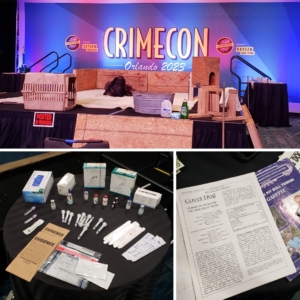
My stomach and chest tightened as I allowed my eyes to take in more details. Strange contraptions. A table of old literature. Another table filled with medical paraphernalia like vials, swabs, blood sample tubes, an IV stand, steroids, sedatives, antibiotics, vaccines, and a stack of professional photography ID cards (just like ones used in a legitimate photography business for models).
The small puppy was next to a blue plastic barrel, a crate used for traveling, and a setup of plywood leaning against chairs. Those were real examples of what Dr. Stern had seen used as dog houses. In fact, everything he had there was either from a real case or facsimiles of things he’s seen during investigations.
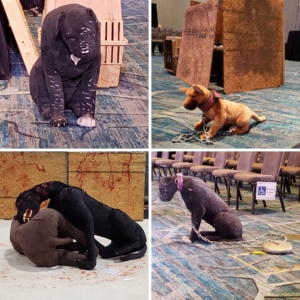
The room’s stage, he described, was quite real to what an actual fighting pit would look like with the black dog model and brown dog model in a twisted up brawl. The floor was often upside-down carpeting so dogs could have better traction. There was a galvanized wash tub with detergents and sponges in a corner. Each dog is bathed by the same person as a type of guarantee that the owner hasn’t covered the dog in something toxic that would harm its opponent in a way other than follow “the rules” established. There are 19 rules, he said. I didn’t get the list of them. One is that there’s an agreed upon weight before the fight and the owners will do anything to the dogs to make sure they are exactly what’s expected at weigh-in time. That weigh-in is done by hanging the dogs by their collars like someone would do with a very large fish.
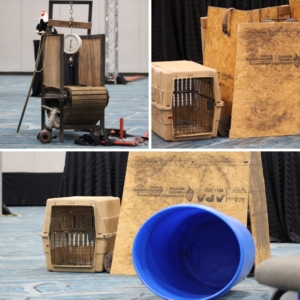
The table filled with literature were genuine periodicals of the dog fighting owner and fan base. These used to be mailed to people before the internet. If you looked at only the photographs in them, you would probably think it was a breeders’ organization about standards with highlights of dogs at the top of their class like a Westminster Kennel Club Champion. That’s not what those magazines were about. They were about top dogs all right, but they were dogs conditioned and trained to maul another animal. Now, the humans involved will avoid mailing anything because that would make it a federal crime.

I took more notes at this presentation than any other—six full pages.
Stern explained that animal investigations have the same rules as human investigations. These are cases that will go to court and need to be beyond a reasonable doubt. At this point, the history of dog fighting seems irrelevant. Ancient Rome and Britain, blah blah blah, military then entertainment, dog versus a larger beast because dog versus dog was illegal. I wasn’t there to get the history. I wanted to know how this horror continues today and what someone in his position as a forensic pathologist does to combat it.
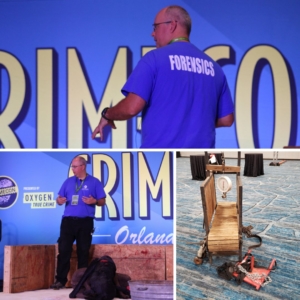
The web of connections from the dog to the actual owner to the event host/organizer to the illegal vet to the fan/gambler and to the owner of the venue creates a lot of groundwork for investigators. Different warrants are needed for each part of it.
A dog’s life begins with extreme neglect and traumatization at The Yard. It would forced to wear a heavy collar that, for its size, it can barely keep its head up. The chains begin at around 20 pounds and as the dog grows, the weight of the chain and the free weight attached are increased in size to build muscle. Multiple dogs will be in a yard tethered to poles in the ground; an example he showed was a simple used car axel. The chains allow for the dogs to get within inches of each other without touching. They have no contact including sexual release. That’s another chapter of their horror story: it’s called a “rape stand” and the female dog will be forced over this contraption with her head locked in a box for her to be impregnated by the male of the owners’ choosing.
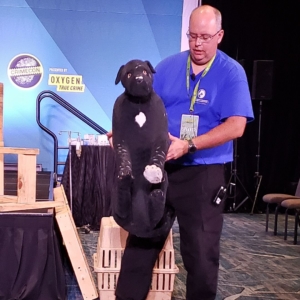
As the dogs are in their yard, they can only walk in circles which create a pattern similar to looking at aerial photographs of crop circles only without the artistic ambition. Once the dogs are old enough, they begin to have test fights. That’s where the humans involved don’t want the dogs to end up dead (yet). Training is done in a stage called The Keep. It’s three to four weeks of intense training like a human athlete. Their reward isn’t a protein shake and Gatorade. A smaller animal like a puppy, a cat, or a rodent would be placed in a pillowcase, beaten, and then given to the dog in training.
While some dogs may have high tech equipment like a treadmill, others have rudimentary substitutes like the “slap mill” with a bait at the front and encased by walls. Those devices do have legitimate uses like physical rehabilitation so they aren’t illegal to manufacture or own.
As soon as they’re deemed ready for The Pit (the fighting ring), then it is usually a fight to the death. Once the dog is at this point where it’s going to be put in real fights, it’s given nutrients (finally decent food), shots of vitamins, steroids, and some have been known to get cocaine before going into The Pit. Even if the winner doesn’t actually kill its opponent, its human owner doesn’t want to waste their precious time in healing the animal so it’ll just get shot (or however they do it). Once a dog loses, it’s done. Losing is a disgrace. The only way the owner can redeem themselves is to kill their dog done through various disgusting ways: electrocution, strangulation with a wire ligature, or shooting if noise isn’t a problem.
The Pit is around 14-20 square feet. The floor is either dirt, concrete, or upside-down carpet. The walls are 2-3 feet high. There’s what’s called a scratch line. This is a line the dogs can’t pass to see if they have what it takes. They get their weigh-in and bath. There are three people in the ring: the “fighters” who are the dog owners and a referee.
It takes three wins to be crowned a Champion. Then five wins to be a Grand Champion. Males only fight males. Females only fight females.
Stern explained that there are three types of people invested in dog fighting:
- The street dog fighter: these are people who have dogs just to have them and occasionally fight.
- The hobbyist: this would be someone like Michael Vick; they’re the as the professional but to a lesser degree. It’s not their full-time job.
- The professional: they are particular about bloodlines and lineage and they have a lot of money involved.
The dog fighting underground scene is closely connected to other illicit activities like drugs, guns, and gambling. These dogs can serve as security systems. They may also have their vocal chords cut to avoid barking yet they can attack. One of the easiest criminal charges that can be brought against these people is practicing veterinary medicine without a license. When there’s a raid, people leave behind a lot of evidence that leads to their capture and arrests. There’s also statistics that prove people who are abusive towards animals have other criminal behavior like domestic violence.

Can the Dogs be Rehabilitated?
Stern didn’t have a clear answer. He said yes and no. These dogs may not be aggressive towards humans which might make them adoptable in a loving and patient home. However, they are animal aggressive. If they see another animal, it’s their training to go after it. They can’t be around other pets or kids. Sometimes, they might land in a proper sanctuary. Often, they’re euthanized. Most of Michael Vick’s dogs were given new homes; one was euthanized.
Stern left us with one busted myth. There’s no such thing as a “bait” dog. That appeared in the media somehow, but it’s not done. Bait is more likely to be cats or other animals to entice the dogs not to practice fighting them.
Donate to the Humane Society!
TopNow, it’s not much of a palette cleanser, but if you’re already crying and want to see something with a happy ending, watch Pixar’s Kitbull:

